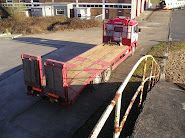Ranging in size from small pedestrien controlled to great big jobs with enclosed cabs. Twin drum rollers can be basically split into 2 types.
This type is controlled by two levers or tillers similar to track levers, each drum is actually two individual drums allowing one side to turn faster than the other and turn the roller. They can be turned within their own length. The drums tend to clog up with mug quite easily and do not have lots of grip when trying to climb the ramps, clearing out the drums with a bar is one option, but if one is available a winch to help or another machine from site will make things much safer.
These machines usually have a single tie down eye on either end.
Articulated rollers are generally a bit easier to work with, they steer via a pivot joint like a dumper and are controlled by a steering wheel. There are no pedals however, you set the revs on a hand throttle and push a lever forwards or backwards to control the direction of travel, this is at least progressive so you can still have some control. Smooth drum rollers also require assistance if the ramps are wet or muddy.
These rollers usually have a slot for chains on each corner above the drum as seen below.
The bigger rollers with cabs are basically a similar principle to control. Tie downs are usually provided on each corner.
Access Platforms
Typically boom lift or scissor lift. I'm no expert on these so info is a little sketchy.
Scissor lifts
Scissors give a nice flat platform that goes straight up and down. Controlled from the basket. Various sizes from narrow one man units to whacking great machines.
The control box is usually movable and clips on the handrail. Simple controls but requiring careful use. The joystick controls movement forwards and backwards, but is only operative when a deadman switch is also pressed in. Steering is a little rocker switch on the top of the stick, this is where things get tricky. As it is an electric switch it has no feel, so you need to be looking at the wheels to make sure they are aligned correctly, also they do not self centre so they will require the you to steer the opposite direction to straighten up again.
The good news is that they usally have great big tie down eyes on either end.
Boom Lifts
Boom lifts are much more complex as the basket is elevated on a boom, can be tilted and the boom rotates around the chassis. These have two sets of controls, one is on the side of body and can be used to move the platform only (If I recall correctly) There is a switch to pass control to the basket. In the basket there are two joysticks and a deadman pedal which must be pressed to activate the controls. Steering is as per a scissor lift and is quite unusual as you are quite distant from the chassis. The machine will travel much more slowly when the basket is higher than a few feet or slewed round. Again these have tie down eyes on either end.
Watch out for the weight of these things, they are much heavier than they look. The weight should be stamped on a plate on the chassis.
Vehicles
Having a beaver tail and a winch is bound to get you collecting one of the works vans that has broken down, or just collecting and delivering cars and vans at some stage. It's also handy as you can take a van with you when you drop the truck for repairs and you can get home without relying on someone else.
I usually use the front and rear towing eyes to secure vehicles with a single strap on either end, our little pickup hasn't got them however and I strap the hooks through the holes on the steel wheels.
Fuel drums / tanks / IBC's
Invariably moving machinery around will find you presented with some fuel to move. Basically you can transport a small amount without ADR as long as you stay within some parameters.
Approved containers. 45 gallon drums, fuel cubes & flasks or IBC's
Qty. You cannot carry in excess of 1000l of fuel. Also you cannot carry a tank or bowser with a greater capacity than 1000l unless it is empty.




No comments:
Post a Comment